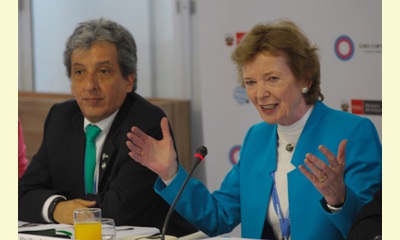|
|
Climate action: the race to Paris
un article par Mary Robinson, the Elders
[Notes: COP stands for Conference of the Parties
of the United Nations Framework Convention on
Climate Change. In July 2014, the UN Secretary-
General named Mary Robinson his Special Envoy
for Climate Change.] 
Mary Robinson with COP20 President Manuel Pulgar-Vidal on 10 December 2014.
click on photo to enlarge
Leaving COP20 Lima, there was a sense that not
enough had been done by countries which can
afford to wait, countries which have the resources
to protect their people and adapt to climate
change. The leaders of countries whose people
are already suffering, who are most at risk and
have least resources to mobilise for protection,
were the ones who compromised the most in
Lima. They cannot afford to wait for political
negotiations as they are already experiencing the
reality of climate change now, although they are
least responsible for causing it.
There were essentially two products from Lima –
the first is the COP decision, which summarises
what was agreed by over 190 countries present in
the negotiations. The second is an Annex to that
COP decision, which is now the negotiating text
for the global climate agreement which is due to
be finalised in Paris in 2015.
The negotiations on both were tortuous, and the
end documents are ambiguous, full of optionality
and low in ambition. They are certainly of far lower
ambition than I wanted to see.
However, the COP decision and the draft
negotiating text keep the process towards Paris
alive, and I believe that their ambiguity is precisely
what makes it possible to insert ambition into the
process over the coming year. It is now our task to
grasp that opportunity, and build on the Lima
outcomes, so that Paris can create a realistic
foundation for stabilizing our climate at less than 2
degrees above pre-industrial levels, which is the
maximum safe level established by science.
My sense of Lima is that the positive climate
action outside of the negotiations was not
reflected inside the negotiations. Climate actions
are being taken by non-state actors such as civil
society, the private sector, youth, women, faith
groups and indigenous communities who are not
allowed to participate in the formal negotiation
rooms.
In an effort to widen participation the Peruvian
Presidency, under the Minister of the
Environment, Manuel Pulgar-Vidal, made efforts to
bring a larger number of non-state actors’ voices
into the COP by creating a “Lima Climate Action
Day” on the 11th of December. I was pleased to
speak alongside representatives from indigenous
communities and civil society, who called for
greater participation and the inclusion of their
voices in the actual negotiations and for political
will to catch up with what is happening “in the real
world”. This was the common call by the private
sector, the scientific community and
representatives of local governments.
Tony deBrum, Foreign Minister of the Marshall
Islands, who spoke on behalf of his people who
have “nowhere to go” summed up the dialogue
when he emphasised that “the Paris alliance must
mobilise everyone inside and outside the
negotiation room.”
(This article is continued in the discussionboard)
|








|
DISCUSSION
Il n'y pas encore de question liée à cet article.
* * * * *
Commentaire le plus récent:
(The following is continued from the main article listed above.)
Having participated in the Lima Climate Action Day, French Foreign Minister Laurent Fabius, President of COP21, committed to continuing this multi-stakeholder dialogue in Paris next year.
This gives us a real opportunity to ensure that the voices of the most vulnerable and indeed the ambitious business actors are listened to by political leaders.
These stakeholders are willing to take action and recognise the urgency to collaborate in order to achieve the common goal of keeping the warming of the planet below 2 degrees Celsius. If we can properly include the voices of young people, women, the private sector, faith and indigenous communities and people from countries most vulnerable to the impacts of climate change into the decision making processes, we have an opportunity to launch an unprecedented wave of human empowerment, a movement for climate action.
Women’s agency plays a key role in driving innovative climate action and their participation in the ongoing climate debate is a key factor for a fair and equitable climate agreement. The new climate agreement should therefore catalyse gender sensitive climate policy by including gender equality and human rights as guiding principles in the draft text for the 2015 agreement.
I have become convinced that climate change is the biggest threat to human rights in the 21st Century. Human rights provide both a motivation for urgent climate action and a framework to inform mitigation and adaptation actions that benefit both people and the planet.
I was pleased to see Human Rights Day being celebrated for the first time at a COP this year. The Peruvian Presidency has shown real leadership on bringing human rights into the climate discussions. The fact that the French Presidency of COP21 has committed to continuing the tradition of celebrating Human Rights Day in Paris next year gives me hope that we can turn COP21 into a people centred opportunity to move forward together.
As the baton will be passed from Peru to France next year, we have to realise that “The Road to Paris” is really a “Race to Paris’. This race, however, is one in which countries and parties must not race against each other, but where they need to set aside their individual positions and work together in order to win against a rapid warming of the world past an irreparable level and the destruction of the lives and livelihoods of millions of people.
One thing is clear: People, no matter where we live, will be impacted by climate change. . ... continuation.

|
|









